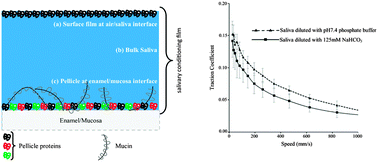Structural modifications of the salivary conditioning film upon exposure to sodium bicarbonate: implications for oral lubrication and mouthfeel
Abstract
The salivary conditioning film (SCF) that forms on all surfaces in the mouth plays a key role in lubricating the oral cavity. As this film acts as an interface between tongue, enamel and oral mucosa, it is likely that any perturbations to its structure could potentially lead to a change in mouthfeel perception. This is often experienced after exposure to oral hygiene products. For example, consumers that use dentifrice that contain a high concentration of sodium bicarbonate (SB) often report a clean mouth feel after use; an attribute that is clearly desirable for oral hygiene products. However, the mechanisms by which SB interacts with the SCF to alter lubrication in the mouth is unknown. Therefore, saliva and the SCF was exposed to high ionic strength and alkaline solutions to elucidate whether the interactions observed were a direct result of SB, its high alkalinity or its ionic strength. Characteristics including bulk viscosity of saliva and the viscoelasticity of the interfacial salivary films that form at both the air/saliva and hydroxyapatite/saliva interfaces were tested. It was hypothesised that SB interacts with the SCF in two ways. Firstly, the ionic strength of SB shields electrostatic charges of salivary proteins, thus preventing protein crosslinking within the film and secondly; the alkaline pH (≈8.3) of SB reduces the gel-like structure of mucins present in the pellicle by disrupting disulphide bridging of the mucins via the ionization of their cysteine's thiol group, which has an isoelectric point of ≈8.3.


 Please wait while we load your content...
Please wait while we load your content...